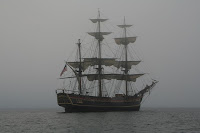Traveling Tuesday: Sailing Vessels and Steamships
 |
| Photo: Pixabay/ Susann Mielke |
My husband and I have been to be able to take quite a few cruises over the years. Gigantic ships that come with stabilizers to ensure smooth passage and engines designed to run efficiently, effectively, and quietly made our journeys delightful excursions. From what I’ve read, the term “cruise” could hardly be applied to ocean-crossing voyages of old.
Scholars know that early civilizations (as long ago as 4,000 years) used watercraft for transportation. It is thought the Egyptians used the first seagoing vessels, followed by the Phoenicians, Cretans, Greeks, and Romans. A thousand years later the Chinese and Japanese travel the internal and coastal waterways. However, it wasn’t until the spice and tea trades arose that shipping came into its own as an industry.
 |
| Photo: Pixabay/enzol |
As understanding of wind and currents progressed, and more speed was desired, the number of masts and configuration of ships changed, as did their names. A brig has two masts that are square-rigged. A full-rigged ship referred to a vessel with three or more masts. Schooners were typically fore-and-aft rigged with the foremast shorter than the mainmast. A variant is the topsail schooner that has a square topsail on the foremast. Additional variants are the barque, barquentine, and brigantine. And don’t forget the galleon or the clipper.
Are you as confused as I am?? Fortunately, there will NOT be a test.
As sailing ships became longer and faster over time, with taller masts and more square sails countries developed large fleets of well-armed warships. However, even the fastest ship couldn’t go more than fifteen knots, or just over seventeen miles per hour. Thus, voyages from Europe to America took from six weeks in good weather to as many as fourteen weeks in inclement weather. A long journey, to be sure.
 |
| Photo: Pixabay/jgerim |
Have you ever taken a cruise? Do you sail or kayak? Or would you rather stay on land?
___________________________
Gold Rush Bride Tegan
She’s out to prove herself. He’s only looking for adventure. Neither one realizes they’ll find more than gold “in them thar hills.”
Tegan Llewellyn has always been different than her adopted family, except Grandmother Hannah, a prospector during the 1829 Georgia gold rush. Now, seventy years later there are reports of gold in Nome, and the opportunity is too good to pass up. But Tegan doesn’t count on the dangers that strike from the moment she steps off the steamer, including the threat of losing her heart.
Elijah Hunter has prospected for gold all over the US and Canada and likes being on the move. The last thing he expects to find on his latest search is a lady miner who proves to be nothing but trouble. Can he convince her that leaving is for her own good before it’s too late...for both of them?
Gold Rush Bride Tegan is part of the exciting multi-author Gold Rush Brides series set in 19th century America. First, there was Hannah, then Caroline, and now Tegan. If you enjoy clean romances with a taste of intrigue, you’re sure to enjoy this series of books. You might even catch some gold fever of your own.
Purchase Link: https://amzn.to/3HClHA0


I've been on a dozen cruises, from Australia to South America, and several European, Caribbean, and Alaskan. It's a great way to travel solo.
ReplyDelete